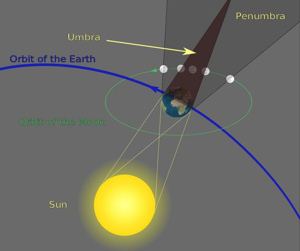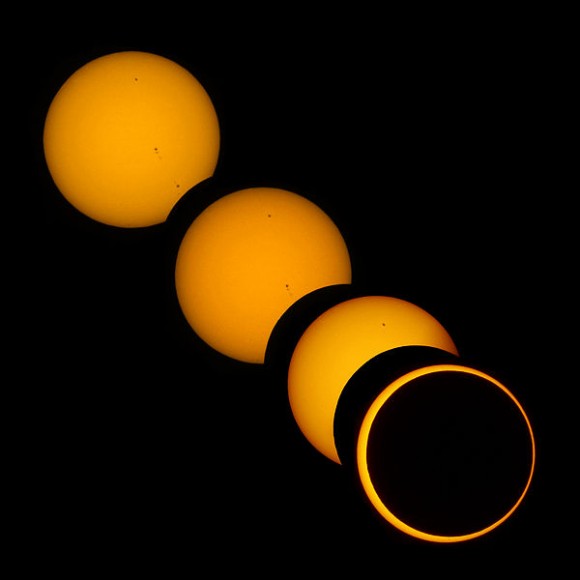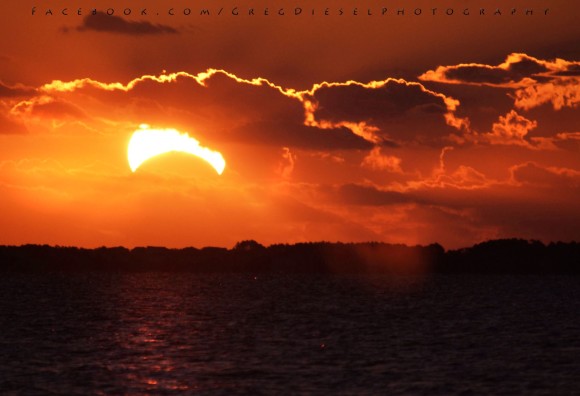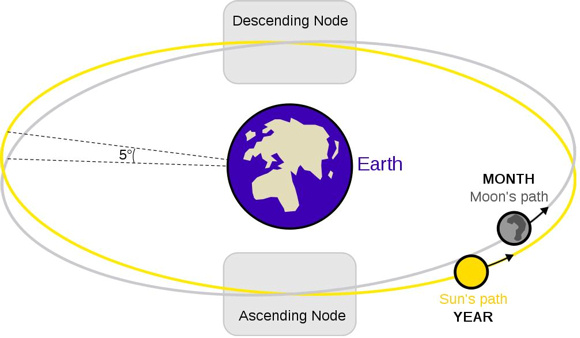

There are at least four eclipses every year – two solar and two lunar. Four is a common number of eclipses in a year; for example, the years 2015 and 2016 have four eclipses. But four is also the minimum number. Depending on the year, there can be four eclipses, five eclipses, six eclipses or a maximum of seven eclipses in a single year. In a previous article, we found that it’s extremely rare to have seven eclipses in a calendar year. The last time was 1982 and the next time will be 2038. On the other hand, it’s much less rare to have seven eclipses in a period of 365 days. Follow the links below to learn more:
Four eclipses in the years 2015, 2016 and 2017
It’s rare to have seven eclipses in a calendar year
It’s not so rare to have seven eclipses in 365 days
Fortnight, lunar month and lunar year
How often do three eclipses happen in one lunar month?
Seven eclipses in one lunar year

Four eclipses in the years 2015, 2016 and 2017
Eclipses in 2015
March 20: Total solar eclipse
April 4: Total lunar eclipse
September 13: Partial solar eclipse
September 28: Total lunar eclipse
Eclipses in 2016
March 9: Total solar eclipse
March 23: Penumbral lunar eclipse
September 1: Annular solar eclipse
September 16: penumbral lunar eclipse
Eclipses in 2017
February 10: Penumbral lunar elcipse
February 26: Annular solar eclipse
August 07: Partial lunar eclipse
August 21: Total solar eclipse
It’s rare to have seven eclipses in a calendar year. It’s extremely rare for one calendar year to contain seven eclipses. The last time it happened was 1982. Looking ahead, we will have seven eclipses in a calendar year only twice in the 21st century (2001-2100), during the years 2038 and 2094. There are 3 solar/4 lunar eclipses in the year 2038, and 4 solar/3 lunar in the year 2094.
A calendar year of seven eclipses can also feature 5 solar/2 lunar eclipses, but this last happened in the year 1935 and won’t happen again until the year 2206.
Or you could have 2 solar/5 lunar eclipses in one calendar year, but this last happened in the year 1879 and won’t happen again until the year 2132.
Suffice it to say a calendar year with seven eclipses is indeed rare.
Read more: How many solar and lunar eclipses in one calendar year?

It’s not so rare to have seven eclipses in 365 days. Some might argue that the calendar year is an artificial constraint … and they would be right. What if we shift our focus to a period of 365 days? How often do seven eclipses happen within one-year’s time (365 days)?
Looking at it this way, we find many occurrences of seven eclipses in a period of 365 days. Seven eclipses last occurred in one year’s time from November 13, 2012 to November 3, 2013. It’ll happen next from January 31, 2018 to January 21, 2019.
We list the seven eclipses that take place in a period of one year for the years 2012-13 and 2018-19:
| 2012-13 (Seven eclipses: 3 solar/4 lunar) | 2018-19 (Seven eclipses: 4 solar/3 lunar) |
| 2012 Nov 13 solar eclipse | 2018 Jan 31 lunar eclipse |
| 2012 Nov 28 lunar eclipse | 2018 Feb 15 solar eclipse |
| 2013 Apr 25 lunar eclipse | 2018 Jul 13 solar eclipse |
| 2013 May 10 solar eclipse | 2018 Jul 27 lunar eclipse |
| 2013 May 25 lunar eclipse | 2018 Aug 11 solar eclipse |
| 2013 Oct 18 lunar eclipse | 2019 Jan 06 solar eclipse |
| 2013 Nov 03 solar eclipse | 2019 Jan 21 lunar eclipse |

Fortnight, lunar month and lunar year. Note that a lunar eclipse and solar eclipse always take place within one fortnight (approximate two-week period) of one another.
Any year period containing seven eclipses must also have three eclipses within the framework of one lunar month – the time period between successive new moons or full moons.
In other words: whenever three eclipses happen in one lunar month, it’s inevitable that seven eclipses should occur in one lunar year of 12 lunar months (a period of about 354 days).
How often do three eclipses happen in one lunar month? Any time a lunar month has three eclipses, we automatically know that seven eclipses happen within one-year’s time. We investigate how often this happens by referring to a longer natural unit of time known as the Metonic cycle – a period of precisely 235 lunar months (approximately 19 calendar years).
In our chosen 235-lunar-month (19-year) stretch of time, we start with the solar eclipse of November 13, 2012, and end with the solar eclipse of November 14, 2031. We find that five lunar months contain three eclipses within this particular Metonic cycle (from the new moon of November 13, 2012, to the new moon of November 14, 2031).
Five 3-eclipse lunar months in between Nov 13, 2012 and Nov 14, 2031:
1) 2013: Apr 25 full moon – May 10 new moon – May 25 full moon
2) 2018: Jul 13 new moon – Jul 27 full moon – Aug 11 new moon
3) 2020: Jun 5 full moon – Jun 21 new moon – Jul 5 full moon
4) 2029: Jun 12 new moon – Jun 26 full moon – Jul 11 new moon
5) 2031: May 7 full moon – May 21 new moon – Jun 5 full moon
Read more about the phenomenon of three eclipses in one month
Eclipse seasons come every 173.3 days

Although the moon’s orbit around Earth is inclined at 5o to Earth’s orbit around the sun, the moon crosses the Earth’s orbital plane twice a month at points called nodes. Every 173.3 days, the line of nodes points at the sun, and it’s the middle of the approximate five-week eclipse season (highlighted in gray). During any eclipse season, there are always one solar eclipse and one lunar eclipse, each of which occurs within one fortnight of the other. If the first eclipse arrives early enough in the eclipse season, three eclipses then take place within one lunar month, and it’s inevitable that seven eclipses occur in one year’s time.[/caption]
Seven eclipses in one lunar year. Because three eclipses happen within one lunar month, seven eclipses also have to fall in one lunar year of 12 lunar months, a period of about 354 days.
We list the dates for the first and final eclipses of the five 7-eclipse lunar years during the 19-year (235-lunar-month) period from November 13, 2012, to November 14, 2031:
1) Nov 13, 2012 (solar eclipse) to Nov 03, 2013 (solar eclipse)
2) Jan 31, 2018 (lunar eclipse) to Jan 21, 2019 (lunar eclipse)
3) Dec 26, 2019 (solar eclipse) to Dec 14, 2020 (solar eclipse)
4) Dec 31, 2028 (lunar eclipse) to Dec 20, 2029 (lunar eclipse)
5) Nov 25, 2030 (solar eclipse) to Nov 14, 2031 (solar eclipse)
In short, it’s not all that rare to have three eclipses in one lunar month, or seven eclipses in one-year’s time (365 days).
Bottom line: It’s extremely rare to have seven eclipses in a calendar year. The last time was 1982 and the next time will be 2038. On the other hand, it’s much less rare to have seven eclipses in a period of 365 days. If I’ve counted everything up correctly, seven eclipses occur in the period of 365 days a total of 29 times in the 21st century!











